
views
It isn’t easy being a regional “leader”—or aspiring to become one—when the national polity has veered, de facto, towards a unitary model of government, underpinned by the notions of a “strong” Centre and “uncompromising nationalism”, antithetical to the idea of a federation embodying diverse political beliefs and ideologies. Uddhav Thackeray, the Maharashtra chief minister, severed his party, the Shiv Sena’s 32-year-old alliance with the BJP, to fly solo in his state’s treacherous politics, seek out disparate partners in the Nationalist Congress Party (NCP) and the Congress and hammer out a rather uneasy partnership that birthed the Maharashtra Vikas Aghadi (MVA) coalition government.
Thackeray’s meeting with Prime Minister Narendra Modi, days before the recent cabinet shuffle/expansion last week, triggered the speculation that a BJP-Sena rapprochement was on the anvil. On whose and what terms? The grapevine had it that the once-bitten BJP, which lost a 24-hour government it hastily cobbled in 2019 with a splinter group of the NCP after the Maharashtra elections, was prepared to let Thackeray continue as the CM. That meant that its former incumbent, Devendra Fadnavis, would forsake his ambitions to return in lieu of a berth in the union cabinet. Fadnavis declared that “we may have differences with the Sena but we are not enemies”. Rajya Sabha lawmaker Sanjay Raut—regarded as Thackeray’s ventriloquist as the executive editor of the “Saamana”, the Sena’s mouthpiece—fuelled the buzz, saying the BJP-Sena friendship was “intact”.
In retrospect, Raut was out of tune with his leader’s thoughts and plans. It seemed Thackeray was in no hurry to abandon the MVA and embark on another adventure with the BJP. The idea of losing Maharashtra was irreconcilable to Fadnavis and the BJP, because it is not just another state. It is still the vault of financial power, with Gujarat a close second.
Thackeray has never had it smooth in his first stint as the CM. The BJP did not pass up a chance to trip him up. He had the unenviable task of marrying the Sena’s volatile and communally divisive legacy bequeathed by the founder, Bal Thackeray, with the exigencies of the “secular” politics the Congress swears by, at least notionally. The NCP and its president, Sharad Pawar, who covertly appropriated the credit for creating the MVA experiment, subject Thackeray to their own pulls and pressures. The government was beset with contradictions, with survival being the only glue that kept the parties together.
Thackeray’s test in balancing extreme political exigencies came when the Centre’s amended citizenship law was voted upon in Parliament. The Sena offered conditional support to the law but allowed peaceful demonstrations against the Act in Maharashtra without unleashing the cops on the protesters as it happened in parts of the country. Thackeray had agreed in principle to withdraw the cases filed against activists in the Bhima-Koregaon violence of 2018; he has not made good his promise so far. When Father Stan Swamy, a Jesuit priest, was taken in custody by the NIA and lodged in Maharashtra’s Taloja Central Jail, various activists had appealed to the CM to provide the ailing octogenarian with basic amenities like a sipper. After Swamy’s death in custody, several opposition leaders, including Pawar, sent a missive to the President of India, seeking a direction to the Centre to act against those responsible for his “continued detention” and “inhuman treatment in prison”. Thackeray did not sign the letter that also asked for the release of the Bhima-Koregaon detainees.
Despite the tightrope walk, pushed by the need to keep his own core voters and a large constituency wedded to “Hindutva” and “nationalism”, Thackeray signalled loud and clear that a reunion with the BJP was not an option. As early as March, he proposed building an Urdu Bhawan and earmarked Rs 1.5 crore from the Brihanmumbai Municipal Corporation (BMC)’s budget for the project. The proposal, which envisages setting up a research centre, an auditorium and a library, was motivated with an eye on the BMC polls in 2022. Of the 227 seats, Muslims matter in 30 and have traditionally voted the Congress or the Samajwadi Party. The Sena is trying hard to woo the Muslims and undo the discomfort among the minorities after its support to the citizenship law.
Other developments invalidated the rapprochement theory. As many as 12 BJP legislators were suspended for “misbehaving” with the presiding officer of the legislative assembly when the monsoon session began last week. The provocation was a resolution moved by the government to seek empirical data from the Centre in order to restore reservation to the OBCs that was abolished by a Supreme Court order. The induction of Narayan Rane in Narendra Modi’s cabinet was also a signal to the Sena of the BJP’s intention to strengthen its base. Rane is a Maratha leader from Konkan who was the Sena’s CM. He quit the Sena after Thackeray junior’s rise but continues to be a red rag to the party.
Underlying the political arguments is a fundamental factor: Thackeray is counted among the strong regional leaders, his intrinsic value being enhanced by governing a state like Maharashtra. He has refashioned Sena 2.0 in his own way, softening the harsh edges of its Hindutva advocacy in a more pluralistic manner that adheres to the precept of “Sarva Dharma Samabhava” without sounding irreligious or pandering to the minorities. He also opposed the sort of militant vegetarianism propagated by the BJP, knowing that first and foremost, culinary fundamentalism will anger the Maharashtrians who love their fish, fowl and meat.
While a non-BJP, non-Congress front seems potentially unrealisable right now, the temptation among regional chieftains to morph into national players is too great for Thackeray to resist.
Perchance, he would bear in mind the fate that befell Nitish Kumar, the Bihar CM, after he made up with the BJP. Nitish touched the apogee of his politics in 2015 when, together with the RJD and Congress, he made the BJP bite the dust in the assembly elections and returned as the CM. This after a rout in the 2014 Lok Sabha elections. Nitish was even looked at as the PM who could possibly head a “secular” coalition at the Centre.
Nitish saved his job in Patna. But he has become such a BJP appendage that he cannot even leverage his influence to extract the ministerial berths he wanted at the Centre. Would Thackeray wish to go the Nitish way? Despite the pinpricks from the Congress, Thackeray knows the Grand Old Party is a shadow of its former incarnation, lacking the strength to pull down his government. Had the GOP been what it was, it might not have entered into a pact with the Sena. The BJP is in a commanding position and can play around with the regional leaders.
Read all the Latest News, Breaking News and Coronavirus News here.

















Comments
0 comment